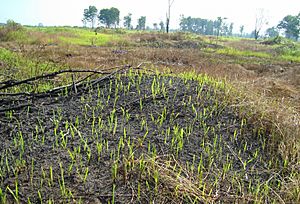Shifting cultivation facts for kids
Shifting cultivation is a way of farming where people grow crops on a piece of land for a short time. After a few years, they move to a new area. They let the old land rest and grow back its natural plants. This helps the soil get healthy again before anyone uses it for farming in the future.
Contents
What is Shifting Cultivation?
Shifting cultivation is an old farming method used in many parts of the world. It is also known as "slash-and-burn" farming in some areas. This is because farmers often cut down trees and plants, then burn them. The ash from the burnt plants helps to make the soil more fertile.
How Does It Work?
Farmers usually pick a small area of forest or bush. They clear the land, often by cutting down trees and burning the leftover plants. This burning helps to clear the land quickly. It also adds nutrients to the soil from the ash. These nutrients help crops grow well for a few years.
After farming on one piece of land for a short time (usually 1-3 years), the soil starts to lose its nutrients. Weeds might also become a problem. When this happens, the farmers move to a new area. They leave the old land alone. This resting period is called a "fallow" period. It can last for many years, sometimes 10 to 20 years or even longer. During this time, the natural plants grow back, and the soil gets its nutrients replenished.
Why Do Farmers Use It?
- Natural Fertilizer: Burning plants adds ash to the soil. This ash acts like a natural fertilizer, helping crops grow without needing to buy expensive chemicals.
- Clearing Land: It's an easy way to clear land for farming, especially in areas with thick forests.
- Low Cost: Farmers don't need many tools or a lot of money to start. They use what is available in nature.
- Sustainable (if done correctly): If there is enough land and the fallow periods are long enough, the land can recover fully. This makes it a sustainable way to farm for small communities.
Is It Good or Bad?
Shifting cultivation can be good for small groups of people. It helps them grow food without harming the land too much, as long as they have enough space and time for the land to recover.
However, if too many people use this method in a small area, or if the land is not given enough time to rest, it can cause problems:
- Deforestation: Too much clearing of land can lead to fewer forests.
- Smoke and Air Pollution: Burning large areas can create a lot of smoke. This smoke can cause air pollution and health problems.
- Soil Erosion: When land is cleared and left bare, heavy rains can wash away the topsoil. This makes the land less fertile.
- Loss of Biodiversity: Clearing forests can destroy the homes of many plants and animals.
Today, many governments and environmental groups are working with farmers. They want to find ways to make farming more sustainable. This includes finding better ways to use land and protect forests.
Images for kids
See also
 In Spanish: Agricultura itinerante para niños
In Spanish: Agricultura itinerante para niños



